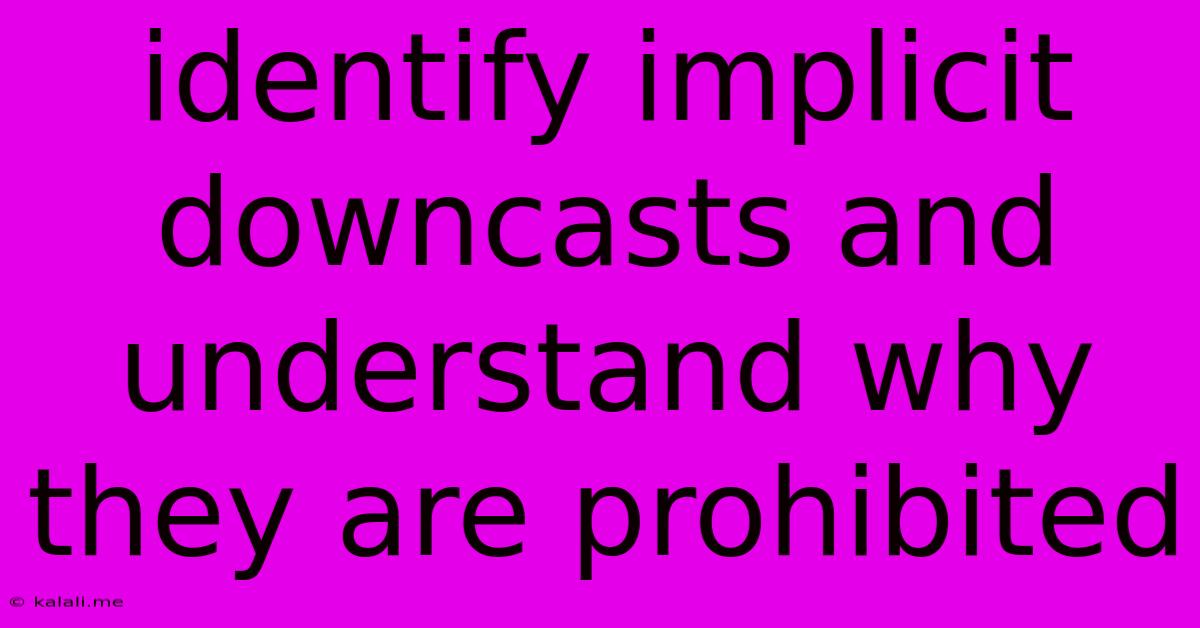Identify Implicit Downcasts And Understand Why They Are Prohibited
Kalali
Jun 10, 2025 · 3 min read

Table of Contents
Identify Implicit Downcasts and Understand Why They Are Prohibited
Implicit downcasting, the silent conversion of a data type to a less precise one, is a common source of errors in many programming languages. Understanding why these are prohibited is crucial for writing robust and reliable code. This article delves into the mechanics of implicit downcasting, explores the dangers it poses, and explains why most modern languages actively prevent or restrict such conversions.
What is Implicit Downcasting?
Implicit downcasting occurs when a variable of a more general type (supertype or parent class) is automatically treated as a variable of a more specific type (subtype or child class) without explicit casting. This often happens when the compiler or runtime environment assumes the conversion is safe, but this assumption is frequently incorrect and can lead to unexpected behavior or crashes. Consider an example in a language with inheritance:
Let's say we have a Animal class and a Dog class, where Dog inherits from Animal. An Animal variable might hold a Dog object, but not vice-versa. Implicit downcasting would occur if the system tried to treat an Animal variable directly as a Dog without verification.
Why Implicit Downcasting is Prohibited (or Restricted)
The primary reason for prohibiting or strongly discouraging implicit downcasting boils down to data safety and type integrity. Here's a breakdown:
-
Data Loss: A subtype often contains more information than its supertype. Implicit downcasting risks discarding this crucial data. Imagine downcasting a
Doubleto anInteger– fractional information is lost. Similarly, in object-oriented programming, downcasting anAnimalto aDogmight fail if theAnimalvariable actually holds aCatobject. -
Runtime Errors: The most dangerous consequence of implicit downcasting is the potential for runtime errors. If the program attempts to access members specific to the subtype (e.g., trying to call a
bark()method on anAnimalthat isn't aDog), the program will crash or produce unpredictable results. This is especially problematic because the error might not manifest during compilation, only during execution, making debugging more difficult. -
Maintenance Nightmares: Code that relies on implicit downcasting is significantly harder to maintain and understand. The implicit nature of the conversion obscures the potential for errors and makes it difficult to track down the source of unexpected behavior. Explicit casting, on the other hand, makes the programmer's intent clear and allows for better error handling.
-
Security Risks: In some situations, implicit downcasting could create security vulnerabilities. If unchecked, an attacker might be able to manipulate data types to gain unauthorized access or execute malicious code.
Explicit Casting vs. Implicit Downcasting
Explicit casting, on the other hand, forces the programmer to acknowledge and handle the potential risks of data type conversion. By explicitly stating the conversion, developers are more likely to anticipate and mitigate potential problems. Explicit casting also makes the code easier to read, understand, and maintain. Most languages provide mechanisms for explicit casting, often using keywords like (type) variable or similar syntax.
Best Practices
To avoid the pitfalls of implicit downcasting:
-
Favor Composition over Inheritance: In object-oriented programming, consider using composition (having objects contain other objects) instead of inheritance in certain situations to reduce the risk of type mismatches.
-
Use Polymorphism: Employ polymorphism to allow for flexible handling of objects without explicit downcasting. This approach leverages the power of method overriding and interfaces to handle objects based on their behavior rather than specific type.
-
Always Perform Explicit Type Checks: Before attempting any cast, always check the actual type of the object using
instanceof(or equivalent) operators to ensure the conversion is safe. -
Implement Robust Error Handling: Use exception handling mechanisms (try-catch blocks) to gracefully manage potential runtime errors that could arise from type-related issues.
By understanding the dangers of implicit downcasting and following these best practices, developers can create more robust, reliable, and secure software. Explicitly managing type conversions is a vital aspect of writing high-quality code.
Latest Posts
Latest Posts
-
Who Is Marty In Christmas With The Kranks
Jun 10, 2025
-
How To Get Rid Of Lead Paint
Jun 10, 2025
-
Convert Duration To A Number Sheets
Jun 10, 2025
-
What Does Syncing With Icloud Mean
Jun 10, 2025
-
Size Of Wire For 100 Amp Service
Jun 10, 2025
Related Post
Thank you for visiting our website which covers about Identify Implicit Downcasts And Understand Why They Are Prohibited . We hope the information provided has been useful to you. Feel free to contact us if you have any questions or need further assistance. See you next time and don't miss to bookmark.